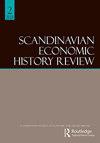“过度负债”——还是不负债?19世纪瑞典的家庭债务积累和风险暴露
IF 1
Q4 ECONOMICS
引用次数: 2
摘要
摘要鉴于目前正在进行的关于现代信用社会中家庭部门金融风险水平不断上升的广泛讨论,本研究探讨了19世纪瑞典信贷市场的水平和结构。越来越多的国际研究关注正规机构之外的非正规信贷市场,这表明,在现代欧洲早期,信贷在所有个人间金融关系中占有很大份额。在这项特别的研究中,基于遗嘱认证清单和反向死亡率法,对19世纪信贷市场结构的变化进行了估计。家庭财务状况被研究为生命周期债务,以及与收入、财富和金融资产相关的债务比率,以及这些比率在19世纪瑞典从以农业为主的经济向更商业化、货币化和工业化的经济转型期间是如何演变的。本文的原始材料包括来自瑞典南部和中部的5800多份家庭遗嘱认证清单,包括三个农村和两个城市地区。地理选择是基于更广泛的研究项目中使用的样本。它不仅允许对农村和城市地区的债务结构进行比较,还允许对瑞典不同地区的债务进行比较。本文章由计算机程序翻译,如有差异,请以英文原文为准。
‘Over-indebtedness’ – or not? Household debt accumulation and risk exposure in nineteenth century Sweden
ABSTRACT In light of the ongoing extensive discussion concerning the increasing financial risk levels of the household sector in modern, credit-based societies, this study explores the level and structure of credit markets in nineteenth century Sweden. The growing international research focusing on informal credit markets outside formalised institutions has demonstrated that credit was abundantly and pervasively included in the lion’s share of all inter-personal financial relationships in early modern Europe. In this particular study, based on probate inventories and the inverted mortality method, the changing structure of nineteenth century credit market is estimated for the living population. The household financial situation is studied as life-cycle indebtedness and as debt ratios in relation to income, wealth and financial assets and how these ratios evolved during the transformation from a predominately agrarian to a more commercialised, monetised and industrialised economy in Sweden during the nineteenth century. The source material for this article consists of more than 5800 household probate inventories from Southern and Central Sweden, including three rural and two urban areas. The geographical selection is based on a sample utilised in a wider research project. It permits comparisons of debt structures not only between rural and urban areas, but also among different regions within Sweden.
求助全文
通过发布文献求助,成功后即可免费获取论文全文。
去求助
来源期刊

SCANDINAVIAN ECONOMIC HISTORY REVIEW
ECONOMICS-
CiteScore
1.60
自引率
16.70%
发文量
20
期刊介绍:
Scandinavian Economic History Review publishes articles and reviews in the broad field of Nordic economic, business and social history. The journal also publishes contributions from closely related fields, such as history of technology, maritime history and history of economic thought. Articles dealing with theoretical and methodological issues are also included. The editors aim to reflect contemporary research, thinking and debate in these fields, both within Scandinavia and more widely. The journal comprises a broad variety of aspects and approaches to economic and social history, ranging from macro economic history to business history, from quantitative to qualitative studies.
 求助内容:
求助内容: 应助结果提醒方式:
应助结果提醒方式:


